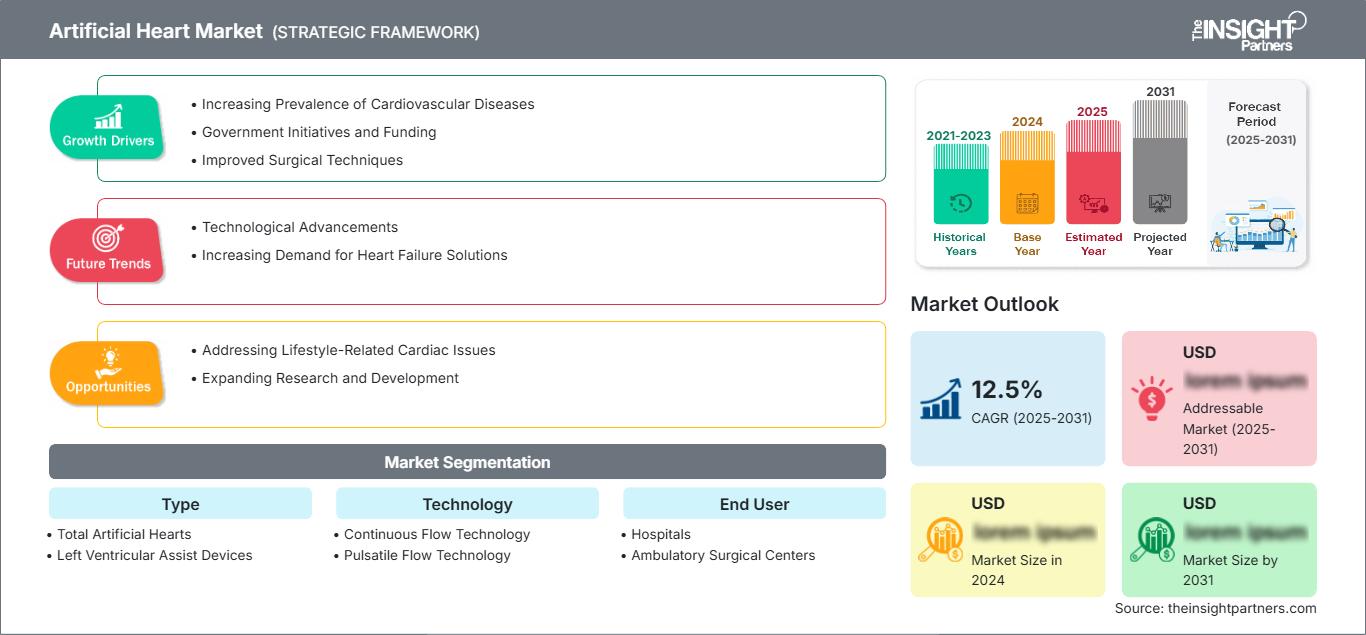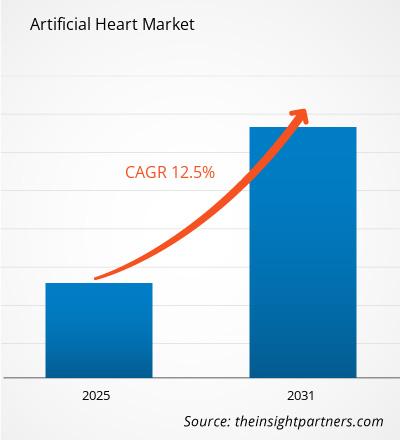Der Markt für künstliche Herzen wird bis 2031 voraussichtlich ein Volumen von 6,95 Milliarden US-Dollar erreichen. Für den Zeitraum 2025–2031 wird eine durchschnittliche jährliche Wachstumsrate (CAGR) von 10,5 % erwartet.
Der Bericht ist segmentiert nach Typ (totale künstliche Herzen (TAH), linksventrikuläre Unterstützungssysteme (LVAD)), Technologie (kontinuierliche Flusstechnologie, pulsatile Flusstechnologie) und Endnutzer (Krankenhäuser, ambulante Operationszentren (ASCs)). Die globale Analyse wird weiter auf regionaler Ebene und für wichtige Länder aufgeschlüsselt. Der Bericht enthält die Werte in US-Dollar für die oben genannten Analysen und Segmente.
Zweck des Berichts
Der Bericht „Markt für künstliche Herzen“ von The Insight Partners beschreibt die aktuelle Marktlage und das zukünftige Wachstum, die wichtigsten Triebkräfte, Herausforderungen und Chancen. Er bietet Einblicke für verschiedene Akteure im Geschäftsbereich, wie z. B.:
- Technologieanbieter/Hersteller: Um die sich entwickelnde Marktdynamik zu verstehen und die potenziellen Wachstumschancen zu erkennen, Investoren: Durchführung einer umfassenden Trendanalyse hinsichtlich Marktwachstumsrate, Finanzprognosen und Chancen entlang der Wertschöpfungskette. Regulierungsbehörden: Regulierung von Richtlinien und Überwachung der Marktaktivitäten mit dem Ziel, Missbrauch zu minimieren, das Vertrauen der Anleger zu wahren und die Integrität und Stabilität des Marktes zu gewährleisten.
Marktsegmentierung für künstliche Herzen: Typ
- Vollständige künstliche Herzen
- Linksventrikuläre Unterstützungssysteme
Technologie
- Kontinuierliche Flusstechnologie
- Pulsierende Flusstechnologie
Endnutzer
- Krankenhäuser
- Ambulante Operationszentren
Geografie
- Nordamerika
- Europa
- Asien-Pazifik
- Süd- und Mittelamerika
- Naher Osten und Afrika
Sie erhalten kostenlos Anpassungen an jedem Bericht, einschließlich Teilen dieses Berichts oder einer Analyse auf Länderebene, eines Excel-Datenpakets sowie tolle Angebote und Rabatte für Start-ups und Universitäten.
Markt für künstliche Herzen: Strategische Einblicke

- Holen Sie sich die wichtigsten Markttrends aus diesem Bericht.Dieses KOSTENLOSE Beispiel umfasst Datenanalysen, die von Markttrends bis hin zu Schätzungen und Prognosen reichen.
Wachstumstreiber für den Markt für künstliche Herzen
- Zunehmende Prävalenz von Herz-Kreislauf-Erkrankungen: Die wachsende Belastung durch Herz-Kreislauf-Erkrankungen ist einer der wichtigsten Faktoren für das Wachstum des Marktes für künstliche Herzen. Im Zusammenhang mit der steigenden Inzidenz von Herzinsuffizienz und anderen Herzerkrankungen wird ein Anstieg des Marktes für künstliche Herzen und zugehörige Geräte erwartet. Auch die zunehmende Verbreitung von Herzinsuffizienz ist ein entscheidender Wachstumstreiber für den Markt für künstliche Herzen. Herzinsuffizienz ist in der Regel mit schwerwiegenden Folgen verbunden, was wiederum den Bedarf an fortschrittlicheren Behandlungsalternativen wie künstlichen Herzen und ventrikulären Unterstützungssystemen (VADs) – um nur einige zu nennen – erhöht. Die steigenden Fälle von Herzinsuffizienz und anderen Herz-Kreislauf-Erkrankungen, die viele Menschen betreffen werden, sind einige der Hauptgründe für das Marktwachstum bei künstlichen Herzen. Neue Trends wie die steigende Inzidenz von Herzinsuffizienz, der Mangel an ausreichend Spenderorganen, der technologische Fortschritt, die alternde Bevölkerung sowie das gestiegene Bewusstsein und die verbesserte Diagnostik tragen alle zur steigenden Nachfrage nach künstlichen Herzen bei. Bei Fortsetzung dieser Tendenzen wird ein Marktwachstum prognostiziert, das Raum für neue Entwicklungen schafft und die Versorgung von Patienten mit Herz-Kreislauf-Erkrankungen verbessert.
- Staatliche Initiativen und Förderung: Staatliche Fördermittel und Initiativen sind entscheidend für die Entwicklung der Kunstherzindustrie. Solche Maßnahmen können Forschung und Entwicklung fördern und kostengünstige Kunstherztechnologien für die Bevölkerung und das Gesundheitssystem zugänglich machen. Institutionen wie das National Heart, Lung, and Blood Institute (NHLBI) und die National Science Foundation (NSF) bieten Förderprogramme zur Unterstützung der Entwicklung kardiovaskulärer Lösungen, einschließlich Kunstherztechnologien. Diese Fördermittel regen die Kreativität an; dadurch entstehen immer ausgefeiltere und effizientere Geräte, die Patienten individuell versorgen können. Auch der technologische Fortschritt im Zusammenhang mit staatlichen Initiativen und Fördermitteln trägt zum Wachstum des Kunstherzmarktes bei, unter anderem durch Forschung und Entwicklung, die Verkürzung von Zulassungsverfahren, die Verbesserung der Gesundheitsaufklärung, die Förderung von Partnerschaften und die Verbesserung des Zugangs. Es sind diese Faktoren, die kumulativ die produktive Entwicklung der Kunstherztechnologie fördern und somit Patienten mit Herzerkrankungen helfen.
- Verbesserte Operationstechniken: Die Entwicklung von Operationstechniken ist einer der wichtigsten Faktoren, die den Markt für Kunstherzen beeinflussen, sowohl die Technologie selbst als auch deren Anwendung. Bessere Operationstechniken tragen zur Verbesserung der Patientenversorgung, zur Vermeidung von Komplikationen und zur Erhöhung der Anzahl der für Kunstherzen geeigneten Patienten bei. Der Paradigmenwechsel hin zur minimalinvasiven Herzchirurgie (MICS) hat den Ansatz zur Implantation von Kunstherzen und anderen Medizinprodukten verändert. Diese Techniken sind zudem mit weniger Trauma für die Patienten, einer schnelleren Genesung und niedrigeren Komplikationsraten verbunden, was die Durchführung von Kunstherzoperationen sowohl für Patienten als auch für Ärzte vorteilhafter macht. Verbesserte Operationstechniken würden bedeuten, dass ein breiteres Spektrum von Patienten für Kunstherzen geeignet wäre und der Markt somit erweitert würde. Zusammenfassend lässt sich sagen, dass die Entwicklung fortschrittlicher chirurgischer Verfahren den Markt für künstliche Herzen fördert, indem sie minimalinvasive Operationen ermöglicht, die Operationsergebnisse verbessert, Interventionen integriert, Menschen zum Erlernen eines spezifischen Handwerks anregt und die gesellschaftliche Akzeptanz solcher Geräte erhöht. Darüber hinaus kommt der Fortschritt und die Weiterentwicklung der künstlichen Herztechnologien Patienten mit Herzproblemen zugute.
Zukunftstrends des Marktes für künstliche Herzen
- Technologische Fortschritte: Technologische Fortschritte sind ein bedeutender Trend, der den Markt für künstliche Herzen prägt, Innovationen vorantreibt und die Behandlungsergebnisse für Patienten verbessert. Diese Fortschritte umfassen eine Reihe von Entwicklungen, die das Design, die Funktionalität und die Integration künstlicher Herzen verbessern. Die Integration digitaler Technologien wie Fernüberwachung und Datenanalyse revolutioniert die Versorgung von Patienten mit künstlichen Herzen. Diese Technologien ermöglichen die Echtzeitüberwachung der Geräteleistung und des Gesundheitszustands des Patienten und somit rechtzeitige Interventionen und eine personalisierte Betreuung. Dieser Trend erhöht nicht nur die Patientensicherheit, sondern stärkt auch das Vertrauen in die Anwendung künstlicher Herzen. Zusammenfassend lässt sich sagen, dass technologische Fortschritte den Markt für künstliche Herzen maßgeblich prägen und alle Bereiche beeinflussen – von Materialien und Design bis hin zum Patientenmanagement und der Integration in digitale Gesundheitstechnologien. Diese Innovationen verbessern nicht nur die Leistung und Sicherheit künstlicher Herzen, sondern erweitern auch deren Verfügbarkeit und Akzeptanz bei Patienten und medizinischem Fachpersonal. Mit der fortschreitenden technologischen Entwicklung werden sich die Fähigkeiten und das Marktpotenzial künstlicher Herzlösungen voraussichtlich weiter steigern.
- Steigende Nachfrage nach Lösungen bei Herzinsuffizienz: Angesichts der zunehmenden Verbreitung von Herzinsuffizienz und anderen Herz-Kreislauf-Erkrankungen steigt die Nachfrage nach effektiven Behandlungsmöglichkeiten. Künstliche Herzen, einschließlich totaler künstlicher Herzen und ventrikulärer Unterstützungssysteme (VADs), werden zunehmend als praktikable Lösungen für Patienten mit schweren Herzerkrankungen anerkannt. Aufgrund der Grenzen konventioneller Behandlungen von Herzinsuffizienz suchen medizinische Fachkräfte verstärkt nach fortschrittlichen Therapien. Künstliche Herzen stellen eine wichtige Option für Patienten mit terminaler Herzinsuffizienz dar, die nicht für eine Herztransplantation infrage kommen. Dieser Trend hin zu aggressiveren Behandlungsmethoden treibt das Wachstum des Marktes für künstliche Herzen voran.
Marktchancen für künstliche Herzen
- Behandlung lebensstilbedingter Herzprobleme: Hersteller von mechanischen Herzen profitieren erheblich von der Zunahme ungesunder Lebensstile, die die Herzgesundheit verschlechtern. Der Bedarf an künstlichen Herzen wird voraussichtlich steigen, da immer mehr Menschen aufgrund ihres Lebensstils Herzprobleme entwickeln. Dies eröffnet einen Markt für innovative Produkte und Therapien. Der Markt für künstliche Herzen bietet vielversprechende Perspektiven, da lebensstilbedingte Herzerkrankungen wie Übergewicht, Bewegungsmangel und ungesunde Ernährung immer häufiger auftreten. Diese Faktoren werden voraussichtlich den Bedarf an neuen Lösungen wie mechanischen Herzen erhöhen, da Herz-Kreislauf-Erkrankungen zunehmen.
- Ausbau von Forschung und Entwicklung: Der Markt für künstliche Herzen wird aufgrund des zunehmenden Wachstums der Forschungs- und Entwicklungsaktivitäten (F&E) einen deutlichen Aufschwung erleben. Dies ist wichtig, um die Wirksamkeit, Sicherheit und Bezahlbarkeit von künstlichen Herztechnologien zu verbessern. Dank der Zusammenarbeit von Forschungseinrichtungen mit Medizintechnikherstellern und Hochschulen werden fortschrittlichere künstliche Herztechnologien entwickelt. Diese Kooperationen ermöglichen den Austausch von Informationen, Ressourcen und Fachwissen, wodurch die Qualität der Designs und ihre Anwendbarkeit verbessert werden. Diese Art der Zusammenarbeit beschleunigt die Entwicklung neuer Ideen und die Markteinführung von Produkten. Zusammenfassend lässt sich sagen, dass der Markt für künstliche Herzen aufgrund der wachsenden Forschungs- und Entwicklungsmöglichkeiten auf allen Ebenen voraussichtlich stark wachsen wird. Die Förderung von Allianzen in der Branche, die optimale Nutzung von Technologie und die Gewährleistung patientenfreundlicher Designs werden den Einsatz künstlicher Herztechnologien effektiver und zugänglicher machen. Forschung und Entwicklung werden auch zukünftig eine wichtige Rolle spielen, um den innovativen Anforderungen des Marktes gerecht zu werden, insbesondere im Bereich der Herzversorgung.
Markt für künstliche Herzen
Die regionalen Trends und Einflussfaktoren auf den Markt für künstliche Herzen im gesamten Prognosezeitraum wurden von den Analysten von The Insight Partners ausführlich erläutert. Dieser Abschnitt behandelt außerdem die Marktsegmente und die geografische Verteilung des Marktes für das Management von Herzrhythmusstörungen in Nordamerika, Europa, Asien-Pazifik, dem Nahen Osten und Afrika sowie Süd- und Mittelamerika.
Umfang des Marktberichts zu künstlichen Herzen
Berichtsattribut Einzelheiten Marktgröße in 2024 US$ XX Billion Marktgröße nach 2031 US$ 6.95 Billion Globale CAGR (2025 - 2031) 10.5% Historische Daten 2021-2023 Prognosezeitraum 2025-2031 Abgedeckte Segmente By Typ - Total künstliche Herzen
- Linksherzunterstützungssysteme
- Kontinuierliche Durchflusstechnologie
- Pulsierende Durchflusstechnologie
- Krankenhäuser
- ambulante chirurgische Zentren
- Nordamerika
- Europa
- Asien-Pazifik
- Süd- und Mittelamerika
- Naher Osten und Afrika
Abgedeckte Regionen und Länder Nordamerika - USA
- Kanada
- Mexiko
- Großbritannien
- Deutschland
- Frankreich
- Russland
- Italien
- Restliches Europa
- China
- Indien
- Japan
- Australien
- Restlicher Asien-Pazifik
- Brasilien
- Argentinien
- Restliches Süd- und Mittelamerika
- Südafrika
- Saudi-Arabien
- Vereinigte Arabische Emirate
- Restlicher Naher Osten und Afrika
Marktführer und wichtige Unternehmensprofile - SynCardia Systems, LLC
- BiVACOR Inc.
- CARMAT
- Cleveland Heart, Inc.
- ABIOMED
- ON-X LIFE TECHNOLOGIES INC
- Abbott
- Cirtec
- Thoratec Corporation
Dichte der Akteure auf dem Markt für künstliche Herzen: Auswirkungen auf die Geschäftsdynamik
Der Markt für künstliche Herzen wächst rasant, angetrieben durch die steigende Nachfrage der Endverbraucher. Gründe hierfür sind unter anderem sich wandelnde Verbraucherpräferenzen, technologische Fortschritte und ein wachsendes Bewusstsein für die Vorteile des Produkts. Mit steigender Nachfrage erweitern Unternehmen ihr Angebot, entwickeln innovative Lösungen, um den Bedürfnissen der Verbraucher gerecht zu werden, und nutzen neue Trends, was das Marktwachstum weiter ankurbelt.

- Holen Sie sich die Markt für künstliche Herzen Übersicht der wichtigsten Akteure
Wichtigste Verkaufsargumente
- Umfassende Abdeckung: Der Bericht bietet eine umfassende Analyse der Produkte, Dienstleistungen, Typen und Endnutzer des Marktes für künstliche Herzen und vermittelt so ein ganzheitliches Bild.
- Expertenanalyse: Der Bericht basiert auf dem fundierten Wissen von Branchenexperten und Analysten.
- Aktuelle Informationen: Der Bericht gewährleistet Geschäftsrelevanz durch die Berücksichtigung aktueller Informationen und Datentrends.
- Anpassungsmöglichkeiten: Dieser Bericht kann an spezifische Kundenanforderungen angepasst werden und sich optimal in die Geschäftsstrategien integrieren.
Der Forschungsbericht zum Markt für künstliche Herzen kann somit maßgeblich dazu beitragen, das Branchenszenario und die Wachstumsaussichten zu entschlüsseln und zu verstehen. Auch wenn einige berechtigte Bedenken bestehen, überwiegen die Vorteile dieses Berichts insgesamt die Nachteile.
- Historische Analyse (2 Jahre), Basisjahr, Prognose (7 Jahre) mit CAGR
- PEST- und SWOT-Analyse
- Marktgröße Wert/Volumen – Global, Regional, Land
- Branchen- und Wettbewerbslandschaft
- Excel-Datensatz
Aktuelle Berichte
Erfahrungsberichte
Grund zum Kauf
- Fundierte Entscheidungsfindung
- Marktdynamik verstehen
- Wettbewerbsanalyse
- Kundeneinblicke
- Marktprognosen
- Risikominimierung
- Strategische Planung
- Investitionsbegründung
- Identifizierung neuer Märkte
- Verbesserung von Marketingstrategien
- Steigerung der Betriebseffizienz
- Anpassung an regulatorische Trends






















 Kostenlose Probe anfordern für - Markt für künstliche Herzen
Kostenlose Probe anfordern für - Markt für künstliche Herzen